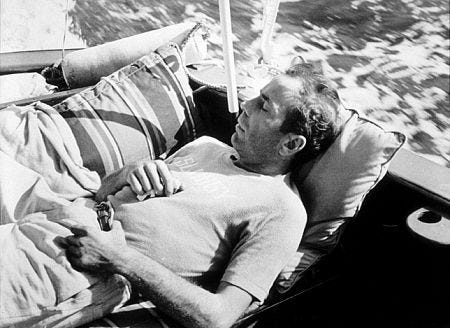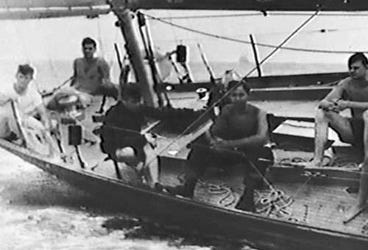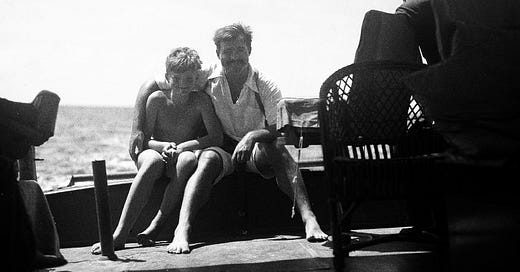Chasing U-Boats with the Hooligan Navy
The odd saga of American yachtsmen guarding America's coasts in World War 2

(The following is a story tailor made for “Eat Your History” because it’s one very few people ever knew about. Nobody thought it worthy of the history books.)
Like most Americans, many men who owned yachts and fishing boats felt their blood boil when Adolph Hitler declared war on the United States, December 11, 1941.
Many of these men were undraftable because of age but wanted to get into the fight anyway. They volunteered their boats for offshore patrols, not only to spot or attack German submarines but to rescue crew members of torpedoed freighters and tankers. Among those volunteering boatmen were author, Ernest Hemingway and Hollywood actor, Humphrey Bogart, who not only saw an opportunity to serve their country but to have a grand time out on the high seas, well stocked with ammunition and whiskey.

The Navy specified these boats to be armed with at least one .50-caliber machine gun and fitted them out to carry up to four, 300-pound depth charges. Hemingway wrangled equipment totaling $32,000, including a long-range radio and a sonar detector in addition to a 20 millimeter gun and the .50-caliber machine gun. In today’s dollars, that $32,000 would equal $580,000.

The Navy reasoned that sailing yachts and pleasure craft would be able to get close to the U-boats without alarming their crews. Hemingway’s plan was to hoodwink surfaced submariners into believing they were just locals out on a fishing trip and wanted to exchange pleasantries with the sailors and maybe sell them some fish and then open fire on them and try to drop some grenades down the hatch.

The official name of this little scratch navy was the “Coastal Picket Patrol” and its boats and volunteers filled a desperate need in the early years of the war. The US Coast Guard was overwhelmed in its effort to safeguard American oil tankers and cargo ships and the Germans were having a field day sinking them, often close to shore. By the beginning of 1942, the German Navy had very nearly defeated United States shipping.
In May, 1942, German submarines sank 42 American freighters in US waters, sometimes within sight of the shore. In one instance the fire from a burning tanker could be seen just off the Florida coast and debris would occasionally wash up on the beaches.
The primary job of this “Hooligan Navy” was simply to watch and listen for U-boats, report any sightings to shore by radio and to maintain contact with potential targets for as long as possible. Beyond that, they played a critical role in rescuing survivors at sea whose ships had been torpedoed. The freelance warriors saved numerous lives, either by directing rescue craft to the site or by bringing survivors directly on board.

The first U-boat skipper to arrive in American waters was Captain Reinhard Hardegan, who guided his submarine smack into New York harbor, brought it to the surface and then looked straight up the brightly lit Broadway.
“I can not describe the feeling in words,” he wrote, “but it was unbelievable and beautiful and great. We were the first to be here and for the first time in this war a German soldier looked out on the coast of the USA.”
A few hours later he torpedoed the Coimbra, carrying 80,000 barrels of oil so close to the shore that people on Long Island called the police to report a fire. Month after month, nobody in the US seemed to get the idea to turn off the lights in coastal cities, resulting in an enormous loss of ships and sailors’ lives. This was later corrected. I remember the twilight blackouts in Daytona Beach when I was a little kid when you had to cover all the windows and use as few lights as possible.
“Against the glare were passing the silhouettes of ships recognizable in every shape and detail as in the outlines in a sales catalog. Here they were formally presented to us as on a plate —- so please help yourselves.”
And until the late spring of 1942, that’s what they did.
Once, off the Florida coast, the Hooligan crew of an armed cabin cruiser were shocked to see the conning tower of a U-boat suddenly break the sea surface only feet away from them. The next minute the German captain popped up out of the hatch and yelled to them in excellent English:
“Get the hell out of here you guys. Do you want to get hurt? Now scram!”

There’s something about a sea adventure that calls a certain type of man, typically one whose bravery outstrips his wit and who likes a good drink now and then. The Hooligan Navy was well staffed with guys who fit that profile.
Over 200 fishing and pleasure craft were authorized by the Navy for coastal patrol duty and you can assume that in the majority of them, the liquor holds were well stocked and frequently re-stocked. Hemingway’s crew on one occasion groused about being short of the promised whiskey and complained bitterly about having to swill gin instead.
But despite the risks and lack of military command, the men who went to sea on those little boats in search of a dangerous enemy in World War 2 were certainly vital to the hundreds of human lives they saved from death.
Final word
Eat Your History is an ongoing research project to find and reveal those unexpected parts of our planet and our past which have been overlooked by the publishers of history.
The clash of empires and the rule of kings inspires no one but those small, telling events, long hidden from view, bring the past alive.
You can be a major part of Eat Your History by becoming a paid subscriber and helping me to continue providing its rich content.
It’s a very real need. I earnestly hope you’ll consider it today.
Heartfelt thanks,
Bob





